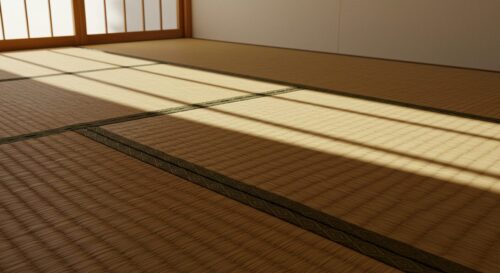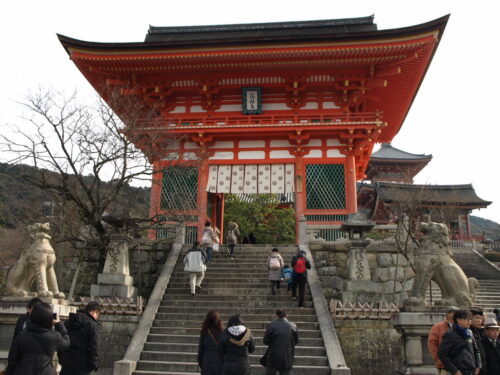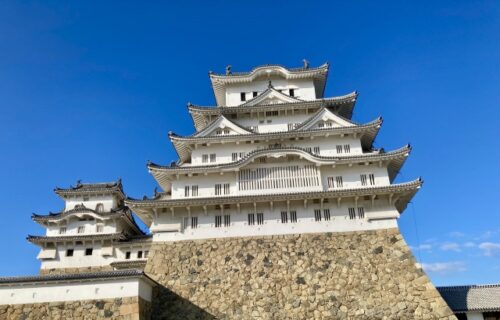A Foreigner’s Handbook: Understanding How to Visit a Shinto Shrine
2025年11月27日
Are you planning a trip to Japan and eager to explore its rich cultural heritage? Visiting a Shinto shrine offers a profound glimpse into Japan’s ancient spiritual traditions, but understanding the proper etiquette can seem daunting for first-time foreign visitors. This comprehensive guide will equip you with everything you need to confidently and respectfully experience a Shinto shrine. From deciphering the significance of the iconic Torii gate and mastering the purification ritual at the Chozuya (Temizuya) to performing the traditional ‘Two Bows, Two Claps, One Bow’ at the main hall (Honden) and exploring unique activities like writing an Ema or collecting a Goshuin, you’ll learn the essential customs and unspoken rules. By following these clear, step-by-step instructions, you’ll not only avoid cultural faux pas but also gain a deeper appreciation for the sacred atmosphere and unique spiritual practices of Japan, ensuring your shrine visit is both meaningful and memorable.
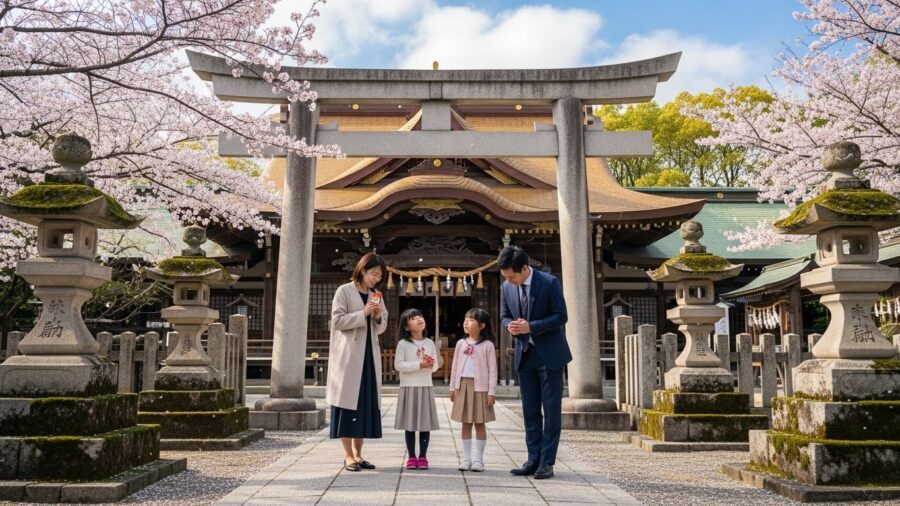
目次
- 1 Welcome to Shinto Shrines An Introduction for Foreigners
- 2 Before You Go: What to Know About Visiting a Shrine
- 3 Step-by-Step Guide How to Visit a Shinto Shrine
- 3.1 Approaching the Torii Gate
- 3.2 Purification at the Chozuya (Temizuya)
- 3.3 How to Perform Temizu
- 3.4 Offering Your Respects at the Main Hall (Honden)
- 3.5 The Saisen Offering
- 3.6 The Two Bows, Two Claps, One Bow Ritual
- 3.7 Other Shrine Activities and Offerings
- 3.8 Writing an Ema Votive Tablet
- 3.9 Drawing an Omikuji Fortune Slip
- 3.10 Collecting a Goshuin Shrine Seal
- 4 Step-by-Step Guide How to Visit a Shinto Shrine
- 4.1 Approaching the Torii Gate
- 4.2 Purification at the Chozuya (Temizuya)
- 4.3 How to Perform Temizu
- 4.4 Offering Your Respects at the Main Hall (Honden)
- 4.5 The Saisen Offering
- 4.6 The Two Bows, Two Claps, One Bow Ritual
- 4.7 Other Shrine Activities and Offerings
- 4.8 Writing an Ema Votive Tablet
- 4.9 Drawing an Omikuji Fortune Slip
- 4.10 Collecting a Goshuin Shrine Seal
- 5 Common Questions About Shrine Visits
- 6 Conclusion
Welcome to Shinto Shrines An Introduction for Foreigners
What is Shinto
Shinto (神道, Shintō), meaning “the Way of the Gods,” is Japan’s indigenous faith, deeply rooted in its ancient traditions. Unlike many other religions, Shinto has no single founder, sacred scriptures, or fixed dogma. Central to Shinto is the worship of kami (神), deities or spirits believed to inhabit natural elements like mountains, rivers, trees, wind, and rain, as well as prominent locations. Kami can also be the spirits of venerated ancestors or exceptional individuals. Shinto is an optimistic faith, emphasizing purity, harmony with nature, and the fundamental goodness of humanity. For more details, visit the Japan Guide Shinto page.
The Significance of Shinto Shrines
Shinto shrines (神社, jinja) are sacred places of worship and the dwellings of the kami. Inside, sacred objects representing the kami are housed, often unseen. Visitors come to pay respects, offer prayers for good fortune, or participate in festivals like Hatsumode (New Year’s first shrine visit). The iconic torii gate marks the entrance, symbolizing the transition into a sacred space. Shrines are vital cultural centers for spiritual reflection and preserving ancient traditions in Japan. Explore more about shrines on the Japan Guide Shinto Shrines page or the Wikipedia Shinto page.
Before You Go: What to Know About Visiting a Shrine
Visiting a Shinto shrine in Japan is a deeply enriching cultural experience. While there isn’t a strict, universally enforced dress code or a rigid set of rules, understanding a few key points about appropriate attire and respectful behavior will enhance your visit and show deference to these sacred spaces. The most important thing is to approach your visit with a respectful mindset, as locals do not expect foreigners to know every custom perfectly.
Appropriate Dress Code
While Shinto shrines do not typically have a formal dress code, choosing modest and neat attire is a sign of respect for the sacred environment and the people who come to worship. Think “smart casual” or “comfy but conservative”.
Consider the following guidelines when planning your outfit:
| Appropriate Attire | Less Appropriate Attire |
|---|---|
| Knee-length skirts or dresses | Short shorts or mini-skirts |
| Long pants or loose-fitting trousers | Overly tight-fitting clothing |
| Shirts that cover shoulders | Tank tops, crop tops, or overly revealing tops |
| Comfortable walking shoes (you may remove them in some areas) | Beachwear or overly casual sandals |
| Hats or caps (to be removed when entering indoor pavilions or during prayer) | Hats worn indoors during prayer or inside pavilions |
Wearing clean socks is also advisable, as you may be required to remove your shoes when entering certain indoor areas within the shrine grounds. Opting for breathable, lightweight fabrics can ensure comfort, especially during warmer months, while still maintaining modesty.
General Demeanor and Respect
A Shinto shrine is a place of worship and spiritual significance, not a theme park. Maintaining a respectful demeanor is crucial. Here are some general guidelines:
- Keep Noise to a Minimum: Speak quietly and avoid loud conversations, running, or disruptive activities. The atmosphere is often one of contemplation and peace.
- Be Mindful of Others: Be aware of other visitors who may be praying or engaged in rituals. Avoid walking directly in front of someone who is praying or between them and the main altar.
- Respect Sacred Objects: Do not touch sacred objects, altars, or offerings unless explicitly invited to do so.
- Photography: Photography is generally allowed on the shrine grounds, but it is often prohibited inside shrine buildings or pavilions. Always look for signs or ask shrine staff if you are unsure. Avoid taking pictures of priests (Kannushi) or shrine maidens (Miko) without their permission.
- Eating and Drinking: It is generally considered impolite to eat or drink while walking around the shrine grounds. If you need to do so, find a designated area or step outside the main sacred space.
- Observe and Learn: If you are unsure about a particular custom, observe what others are doing and try to follow suit. Most locals appreciate the effort to show respect.
By keeping these points in mind, you can ensure a respectful and meaningful visit to a Shinto shrine, appreciating its beauty and spiritual significance without causing unintentional offense.
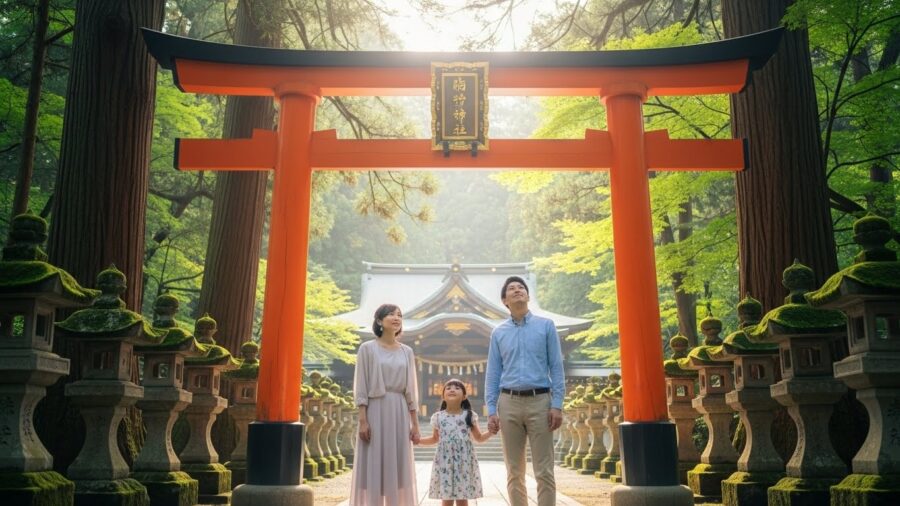
Step-by-Step Guide How to Visit a Shinto Shrine
Approaching the Torii Gate
The torii gate marks the sacred boundary. Bow slightly before passing. Walk along the path’s (sando) sides; the center is for deities.
Purification at the Chozuya (Temizuya)
At the chozuya or temizuya (water pavilion), perform temizu to cleanse hands and mouth. This water is for purification, not drinking.
How to Perform Temizu
| Step | Action |
|---|---|
| 1 | Right hand picks up ladle (hishaku). Pour water over left hand. |
| 2 | Left hand holds ladle. Pour water over right hand. |
| 3 | Right hand holds ladle. Cup left hand, pour water into it, gently rinse mouth. Spit discreetly beside the basin. |
| 4 | Hold ladle vertically to cleanse handle. Return ladle face down. |
Offering Your Respects at the Main Hall (Honden)
After purification, proceed to the main hall (Haiden or Honden) for prayers.
The Saisen Offering
Toss a coin into the offering box (saisen-bako) as saisen. A 5-yen coin (go-en) is popular for “good fortune”. Any amount is acceptable.
The Two Bows, Two Claps, One Bow Ritual
- Stand, make two deep bows.
- Clap hands twice at chest level.
- Keep hands together, offer silent prayer.
- Make one final deep bow.
Other Shrine Activities and Offerings
Optional activities for deeper engagement.
Writing an Ema Votive Tablet
Ema are wooden plaques for wishes or thanks. Hang them at the designated spot.
Drawing an Omikuji Fortune Slip
Omikuji are paper fortune slips. Keep good fortunes; tie bad fortunes to a tree/rack to leave bad luck behind.
Collecting a Goshuin Shrine Seal
A goshuin is a unique calligraphic stamp and seal, collected in a goshuincho (special notebook). It serves as a spiritual souvenir, often handwritten by priests.
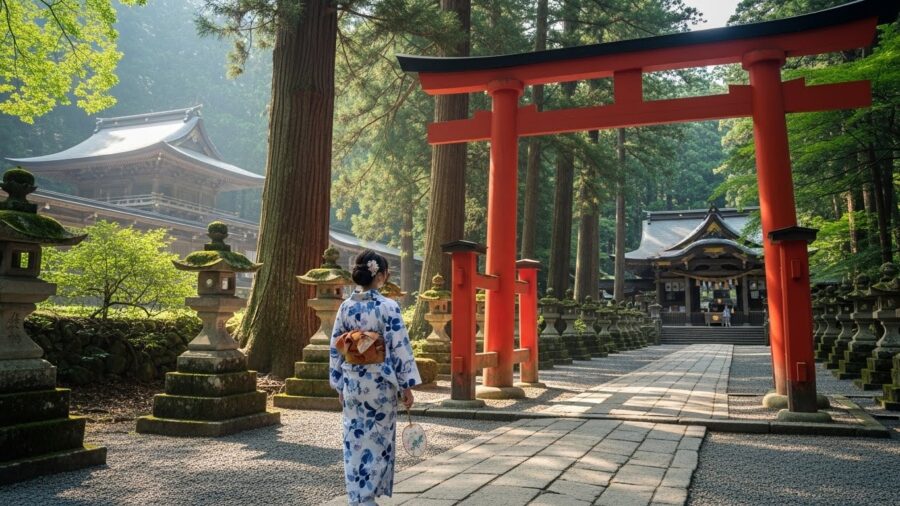
Step-by-Step Guide How to Visit a Shinto Shrine
Approaching the Torii Gate
The torii gate marks the sacred boundary. Bow slightly before passing. Walk along the path’s (sando) sides; the center is for deities.
Purification at the Chozuya (Temizuya)
At the chozuya or temizuya (water pavilion), perform temizu to cleanse hands and mouth. This water is for purification, not drinking.
How to Perform Temizu
| Step | Action |
|---|---|
| 1 | Right hand picks up ladle (hishaku). Pour water over left hand. |
| 2 | Left hand holds ladle. Pour water over right hand. |
| 3 | Right hand holds ladle. Cup left hand, pour water into it, gently rinse mouth. Spit discreetly beside the basin. |
| 4 | Hold ladle vertically to cleanse handle. Return ladle face down. |
Offering Your Respects at the Main Hall (Honden)
After purification, proceed to the main hall (Haiden or Honden) for prayers.
The Saisen Offering
Toss a coin into the offering box (saisen-bako) as saisen. A 5-yen coin (go-en) is popular for “good fortune”. Any amount is acceptable.
The Two Bows, Two Claps, One Bow Ritual
- Stand, make two deep bows.
- Clap hands twice at chest level.
- Keep hands together, offer silent prayer.
- Make one final deep bow.
Other Shrine Activities and Offerings
Optional activities for deeper engagement.
Writing an Ema Votive Tablet
Ema are wooden plaques for wishes or thanks. Hang them at the designated spot.
Drawing an Omikuji Fortune Slip
Omikuji are paper fortune slips. Keep good fortunes; tie bad fortunes to a tree/rack to leave bad luck behind.
Collecting a Goshuin Shrine Seal
A goshuin is a unique calligraphic stamp and seal, collected in a goshuincho (special notebook). It serves as a spiritual souvenir, often handwritten by priests.

Common Questions About Shrine Visits
Is Photography Allowed?
Photography is generally permitted on the outer grounds and of the exterior architecture of Shinto shrines. However, it is often prohibited inside the main halls (Honden) or other shrine buildings, as these are sacred spaces. It is considered taboo to directly photograph figures of deities. Always look for “No Photography” signs or symbols. If you are unsure, it is best to ask a shrine staff member.
When taking photos, be mindful of others. Avoid photographing people praying or participating in ceremonies without their explicit consent, as this can be considered disrespectful. Also, remember to avoid standing in the center of the approach path (sando) for your pictures, as this area, known as the *seichu*, is traditionally reserved for the *kami* (deities).
What if I Don’t Understand Everything?
It is perfectly acceptable for anyone, regardless of their religious beliefs, to visit a Shinto shrine. You are not expected to understand every nuance of Shinto rituals or beliefs, and many Japanese people themselves may not know all the strict procedures. The most important aspect is to approach the shrine with respect and a calm demeanor.
If you are unsure about a specific ritual, observing how local visitors conduct themselves is a good way to learn. The act of visiting and showing respect for the cultural and spiritual practices is highly appreciated. If you have questions, shrine staff or priests may be able to provide guidance.
Can I Enter All Areas?
While most Shinto shrines welcome visitors to their grounds and public areas, such as the approach paths and prayer halls (Haiden), certain sections may have restricted access. The inner sanctuary, known as the *Honden*, where the *kami* is believed to reside, is typically not open to the general public and is usually reserved for priests or special ceremonies.
Always pay attention to signs indicating restricted areas. For instance, the central path (sando) leading to the main hall is traditionally reserved for the deities, so visitors should walk along the sides. Some smaller shrines, particularly those on private property, may not be intended for public visits. If you encounter a rope barrier or a sign, it’s best to respect the boundary.
Conclusion
Visiting a Shinto shrine offers a profound opportunity to connect with Japan’s ancient spiritual traditions and rich cultural heritage. By understanding and respectfully observing customs like purification at the Chozuya and the “Two Bows, Two Claps, One Bow” ritual, you can truly appreciate the deep significance of these sacred spaces. Each step, from passing through the Torii gate to offering respects at the main hall, is an immersion into a realm of tranquility and reverence.
Key Aspects of Your Shrine Visit
| Aspect | Significance |
|---|---|
| Torii Gate | Marks the transition from the mundane to the sacred realm. |
| Temizu (Purification) | Symbolically cleanses the mind and body before approaching the kami (deities). |
| Saisen (Offering) | A gesture of gratitude, respect, and a wish for connection with the kami. |
| “Two Bows, Two Claps, One Bow” | The formal ritual to greet and communicate with the enshrined kami. |
| Ema, Omikuji, Goshuin | Opportunities for deeper personal interaction and understanding of shrine traditions. |
| Respectful Demeanor | Honoring the sacred space, deities, and local customs. |
Shinto shrines are welcoming places for all who approach with an open heart. Even without understanding every detail, the universal principles of purity, gratitude, and harmony with nature resonate deeply. Your visit fosters a beautiful cultural exchange, allowing you to experience Japan’s spiritual essence. We hope this guide empowers you to explore these sacred grounds with confidence, discovering peace and a deeper appreciation for Japan’s enduring spiritual landscape.
